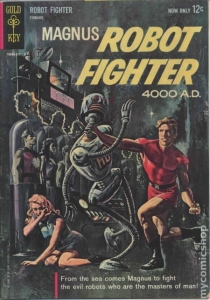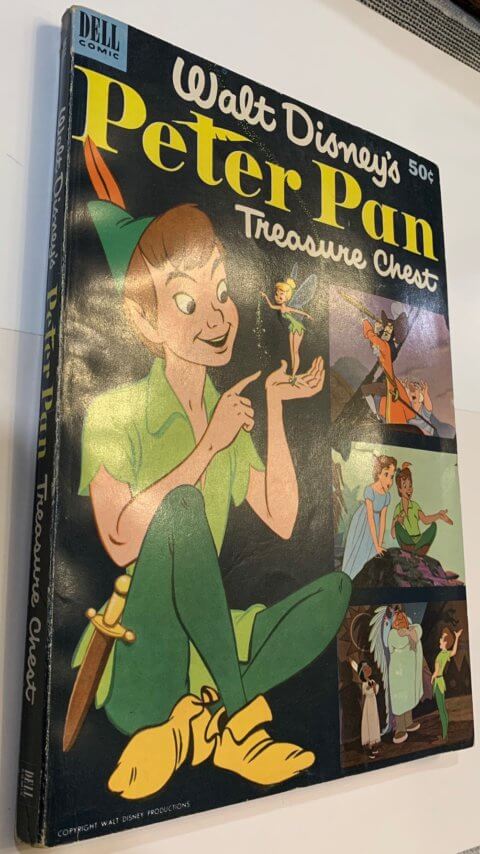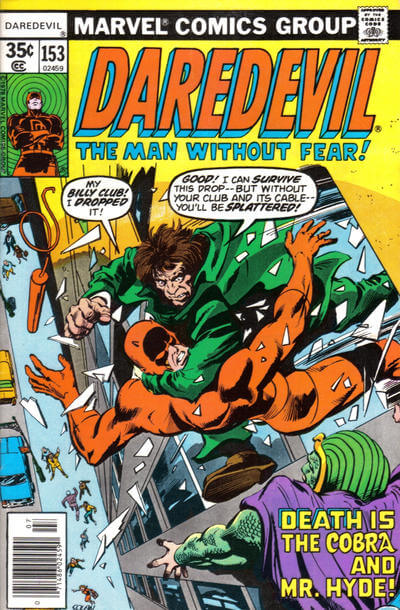 Magnus Robot Fighter #1, Gold Key, February 1963
Magnus Robot Fighter #1, Gold Key, February 1963
A small stack of Gold Key’s came into the shop recently, the best book in the bunch was a beat up copy of this week’s Undervalued Spotlight pick Magnus Robot Fighter #1.
I poked around trying to come up with a price and was surprised at how low the value is in the Overstreet guide and how little graded copies have been getting according to the GPAnalysis site.
Magnus Robot Fighter #1 should be way bigger that it is.
The 1st Gold Key series was launched in the early days of the Silver Age and ran sporadically for 46 issues until 1977. In 1991 Valiant famously relaunched the title under much hype and much more speculation. The Valiant run lasted 64 issues ending in 1996. Acclaim then published an 18 issue run in 1997/98. Dark Horse was next with a 4 issue mini-series in 2010/11. Most recently (2014/15) Dynamite published a 12 issue run of Magnus.
Magnus Robot Fighter has been around, there is a large canon, there’s brand recognition and there has been through all these series’ mentioned above a chance to build multiple fan bases. The book appeals to Silver Age fans, Bronze Age fans, Valiant era fans and modern day fans.
Published in February 1963 this book predates most of the Marvel stable including Spider-Man, Iron Man and the X-Men. That fact alone doesn’t mean much but like I said above the character has been around a long time and he’s stayed around albeit sporadically.
There are 92 CGC Universally graded copies as of this post, a 9.0 will get you into the top 10 copies. I’d consider anything at 8.0 or above as investment grade for this book. The best copy I can find on line as I type this is a CGC 6.5 for $459.
Recent sales include a CGC 5.0 going for $161, a 7.5 for $489, an 8.0 for $657 and an 8.5 for $715. All bargains as I see it.
The 46th Overstreet price break for this book is $285/$641/$1000 in the 8.0/9.0/9.2 grade splits.
Reasons to buy this comic book as an investment.
- 1st appearance of Magnus Robot Fighter
- Long lasting character with good future prospects




Walt
I can’t believe you did a whole post about Magnus without once mentioning Russ Manning. His work on Tarzan has been hailed as the finest since Foster and Hogarth, and his Magnus work is a testament to the great variety of genres he could handle, from ape man to dystopian future. Along with Kubert’s take on Tarzan, I couldn’t get enough of the Manning reprints DC started peppering the giant size issues with in the ’70s. Simply some of the finest comic art you will ever see, and he certainly put some of the slipshod anatomy of his contemporaries to shame.
cheers, mel
Mel !!
Spoken like a true art lover. Apologies, Sometimes I focus too much on the business end with these posts, comments like yours remind me that there is way more to these books than just price analysis. Thanks for your thoughts and insights.
The painted covers are also classic.The Silver Age was full of fantastic comics.
Dennis…painted covers were interesting and a compliment to the usual Dell photo covers. I prefer a painted DC wash but acknowledge gold key painted covers had a unique charm. For me, Star Trek #1 is the most iconic gold key cover!
Mel….Russ Manning did good work, but i think his work on tarzan limited him to a certain house style. To me, Russ Manning was at times a Jesse Marsh immitator! Russ Manning IMO was not as creative as some other artists.
Stan Lee once said the only non marvel book he ever read and liked was Magnus Robot Fighter. I think he was being polite but not entirely truthful. Magnus was a science fiction comic and lost the younger readers. What 8 year old cared about robots in the year 4,000?
Magnus, Robot Fighter was one of the few sci fi comics in an era dominated by superheros.
The artwork of Russ Manning was recognizable!.
In 4000 A.D., when society had grown weak from overreliance on its mechanical servants, Magnus, trained from infancy by Robot 1A, uses his “steel-smashing strength” to defend humanity against evil robots and renegade humans like Mekman, who so idolizes the efficiency of robots that he coats his body with flexible metal in emulation. Aiding Magnus are his beautiful, resourceful girlfriend, Leeja, and her senator father.
Many storues were written by Manning, who was obviously influenced by Isaac Asimov and his famous robotic laws–are a notch more sophisticated than most other comics of its day and remain quite readable.
The 5 most investable gold kets are:
1.1967 StarTrek #1. $2,000
(company folded when Marvel acquired rights)
2. 1980 uncle scrooge # 179. $1500
(Ultra low distribution)
3. 1967. Space Ghost $ 1100
(1966 tv series one shot of Spiegle art)
4. 1970 Scooby- Doo #1. $ 1050
(where are you? TV series)
5. 1963 Magnus Robot Figher #1. $1,000
Honorable mention to first gold key book and Bob Fugitani art:
6. 1963 Dr.Solar. #1 $ 700
( and i cannot not-mention )
7. 1954 Turock son of Stone.Dell $1,500.
The most historic event was in 1980 when marvel comics bought or stold the rights to StarTrek. The original Star Trek gold key book represents the historic origins of Gene Rodenberrys creation. Dell and Gold key as a company folded when Marvel acquired rights to its jewell star trek.
The success of Marvel acquiring Star Trek together with acquiring Star Wars rights by Marvel saved Marvel from bankruptcy, and forever put Marvel into the movies business – thus changing the World. From the small Star Trek acorn, Disney superhero movies grew!
Gold Key gave many artists and writers a start. Writer/artist Russ Manning and editor Chase Craig launched the Magnus, Robot Fighter series in 1963.] Jack Sparling co-created the superhero Tiger Girl with Jerry Siegel in 1968, drew the toyline tie-in Microbots one-shot, and illustrated comic book adaptations of the television series Family Affair, The Outer Limits, and Adam-12. Dan Spiegle worked on Space Family Robinson, The Green Hornet, The Invaders, Korak, Son of Tarzan, Brothers of the Spear, and many of Gold Key’s mystery/occult titles. Among the other creators at Gold Key were writers Donald F. Glut, Len Wein, Bob Ogle, John David Warner, Steve Skeates, and Mark Evanier; and artists Cliff Voorhees, Joe Messerli, Carol Lay, Jesse Santos, and Mike Royer. Glut created and wrote several series including The Occult Files of Dr. Spektor,] Dagar the Invincible, and Tragg and the Sky Gods. Also in the 1970s, writer Bob Gregory started drawing stories, mostly for Daisy and Donald. Artist/writer Frank Miller had his first published comic book artwork in The Twilight Zone for Gold Key in 1978.
Science Fiction hit its stride with Astonding Stories bed sheet pulps in 1930! Sci Fi was the idea that science was the answer to every question. Scientists would rule the world through robotics. Magnus was this idea, 30 years too late. By 1963, the villains were still evil scientists. But, comic book heros had taken over. Science was no longer the problem. Peter Parker was not primarily powerful as a wild science student. Science was not dominant. Rather, his powers were a freak bite from science accident. Science was not a menace. With great powers, responsibility could be used for good.
Magnus was fighing against evil science robots. Mr.Fantastic used science postively to fight evil. Times had changed by 1970 and sci fi became less relevant.
Personally i will take Scooby Doo 1970 #1, or Star Trek 1967 #1, as the better investments of the gold key stables. I would even take Al McWilliams art (Star Trek) over Russ Manning art (Magnus) as being more modern in its lines!
It is iconic to beam-up. Where are you Scooby Do.? We all know Starship Enterprise. Both have enduring collector value.
But who loses sleep worrying about 1A robots in the year 4,000? (nobody that i personally i know and love here in Toronto. )
I will trade a Magnus Robot Fighter #1 in fine condition for a Star Trek #1 in fine, or Scooby Do #1 in fine anytime! Wouldn’t any investment-minded comic fan?
Stevie V.
Good post and finally a well detailed article about early Gold Key Magnus. I have bunch of them, some of them has been reread quite numerous times.
How about a new Undervalued Spotlight on Doctor Solar? It was, based on what I read years ago, the first Gold Key comic book to hit the stands.
Hey Steve
I can tell you for certain that there was at least one eight year old who was thrilled in 1963 to find a comic about robots in the year 4000! Never underestimate the scope of a kid’s imagination.
cheers, mel
Steve V.,
As you mentioned above:
Honorable mention to first gold key book and Bob Fugitani art:
6. 1963 Dr.Solar. #1 $ 700
( and i cannot not-mention )
7. 1954 Turock son of Stone.Dell $1,500.
Do you mean in higher condition?
Nicholas…yes a Dr.Solor #1 1962 in 8.5 sold for $525 in april 2017 at auction. The 2016 guide lists Dr.Solar #1 in top 9.2 grade as worth $650. Only one exists in 9.6 so the eight 9.4s sell over guide. One 9.4 fetched $4,063 in 2015 auction.
Dr. Solar is an American fictional comic book superhero created by writer Paul S. Newman, editor Matt Murphy, and artist Bob Fujitani.
The character first appeared in Doctor Solar, Man of the Atom #1 in 1962 by Gold Key Comic.
Dr Solar, Man of the Atom has many Abilities including… Super-Genius Level Intelligence,
Since the accident that turned him into a godlike being whose body was transformed into pure energy, Solar gained a vast array of powers, energy Manipulation in all its forms, and can also generate, absorb, and convert energy and fire energy blasts, Atomic and subatomic Manipulation, Invulnerability,
Immortality, Superhuman Strength, Speed and Endurance, Teleportation, Flight,
The First original Gold Key character. Origin and first appearance of Dr. Solar is issue #1 1962. This is also the first gold key book. With” Two Dr. Solar stories, “Solar’s Secret!” and “An Atomic Inferno!”and a Painted front and back covers….the Number on cover 10000-210. Cover price $0.12.
Turok four color by dell # 596 (#1) 1954 guides for $2,100 in 2016 in 9.2. An 8.0 just sold for $1673 at auction. Guide for 8.0 is only $600 in 2016. Only 6 copies exist in 9.2 or 9.4 and 3 are in each grade.
Turok ran 130 issues from 1954 until 1982.
Stevie V.
Sorry that Steve doesn’t appreciate Manning’s artwork but I have to disagree strongly with the “Jesse Marsh imitator” crack. Manning’s work had a clean, crispness that makes me think of Curt Swan’s elegant lines. Perhaps no huge innovator but he was perfect for Magnus. After all, they do give out a Russ Manning Promising Newcomer Award, not a Jesse Marsh award. Some kids must’ve liked those crazy future robots, I know I did.